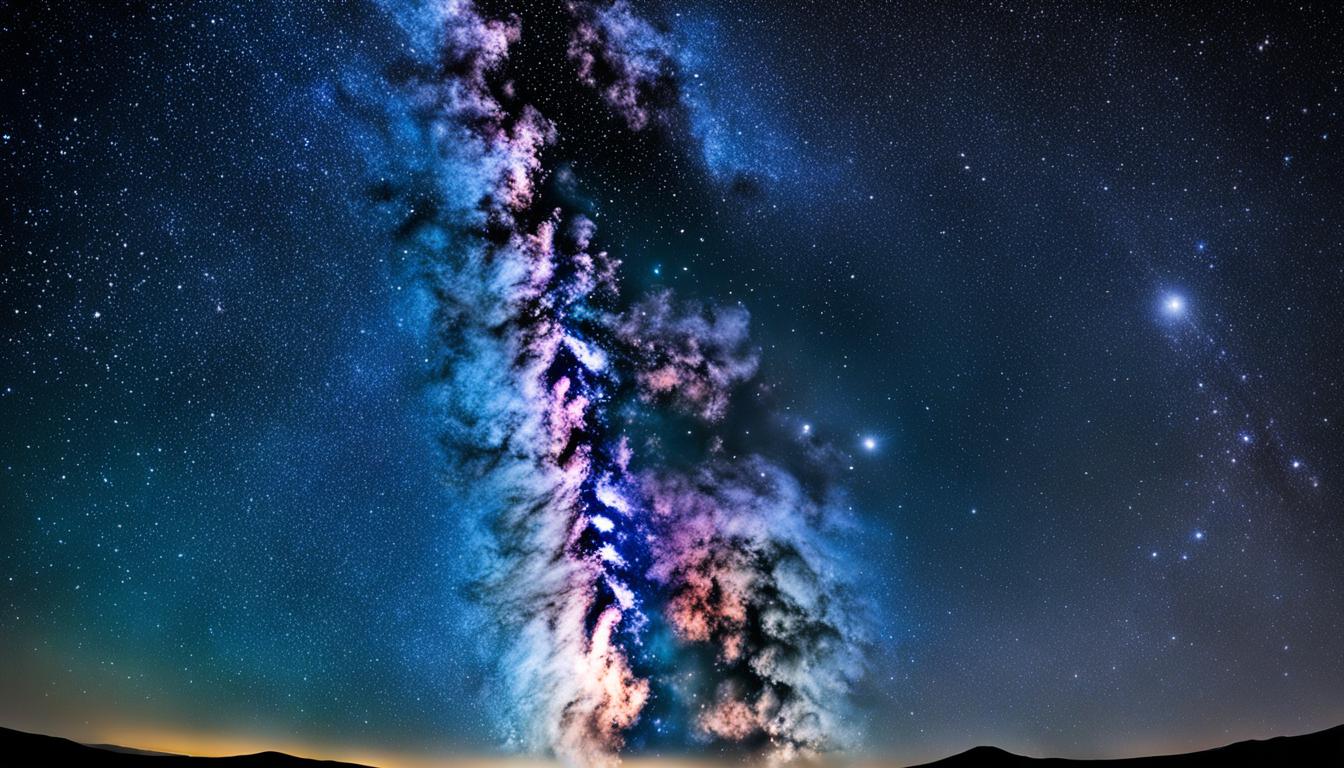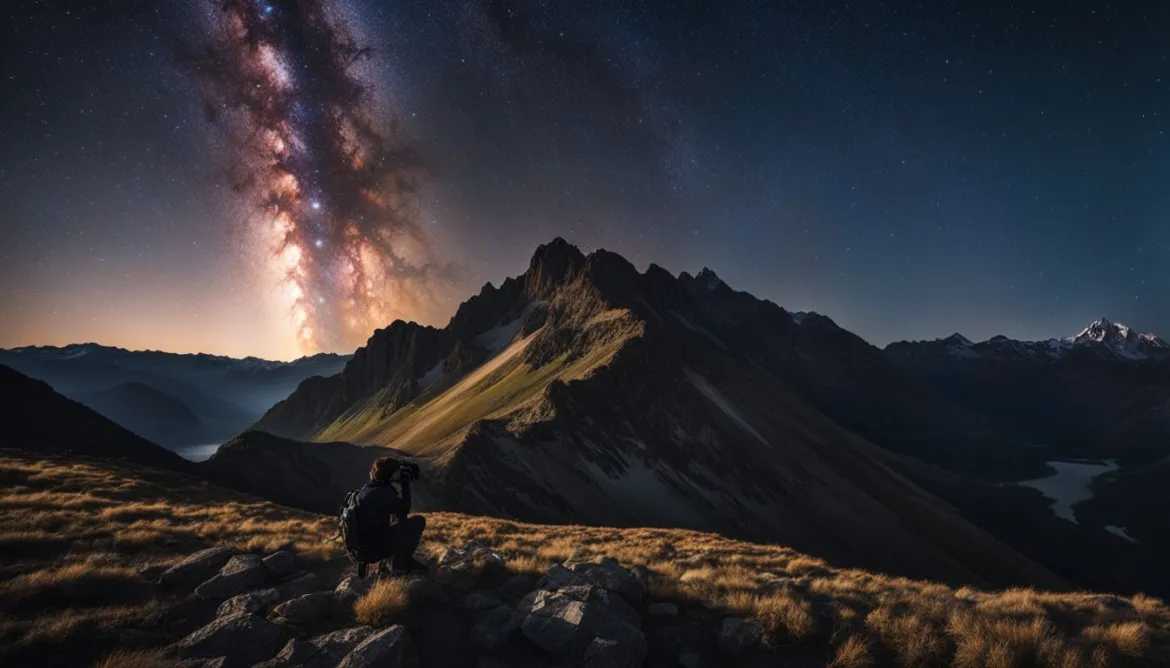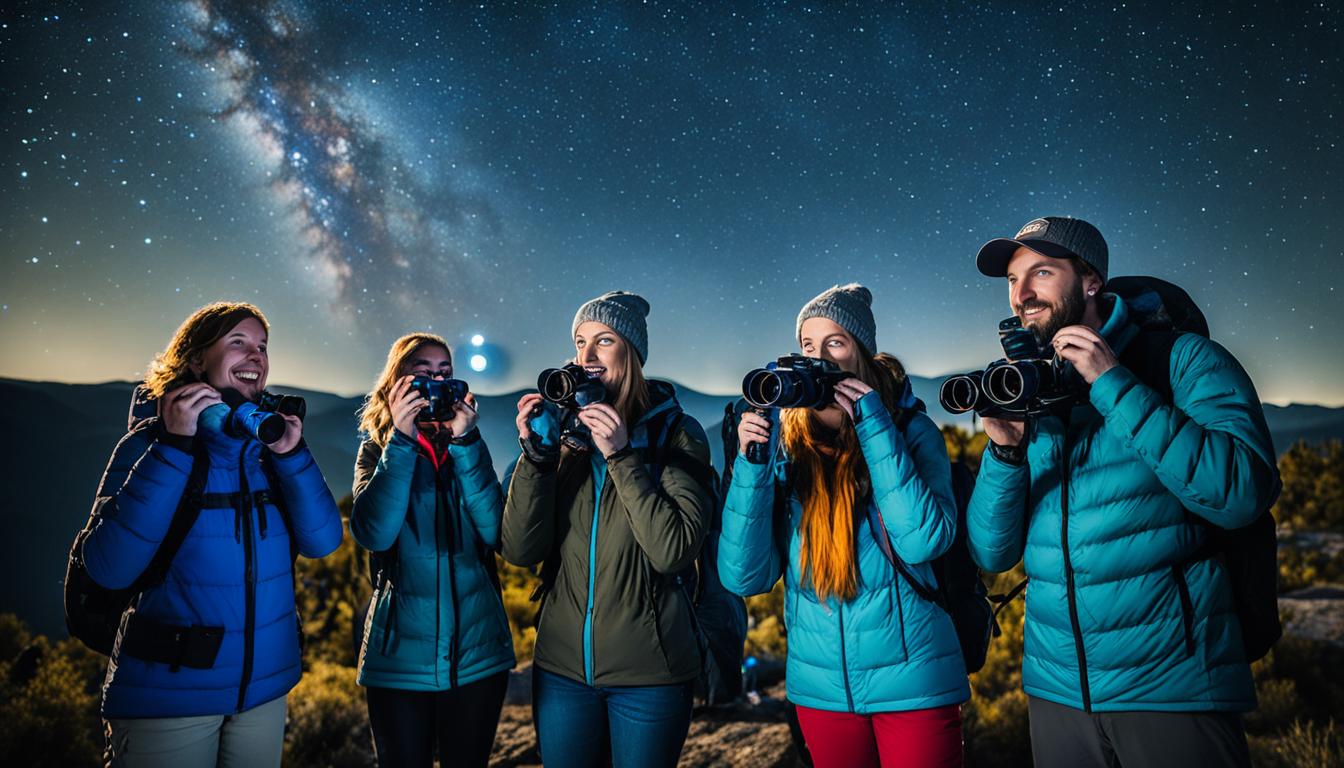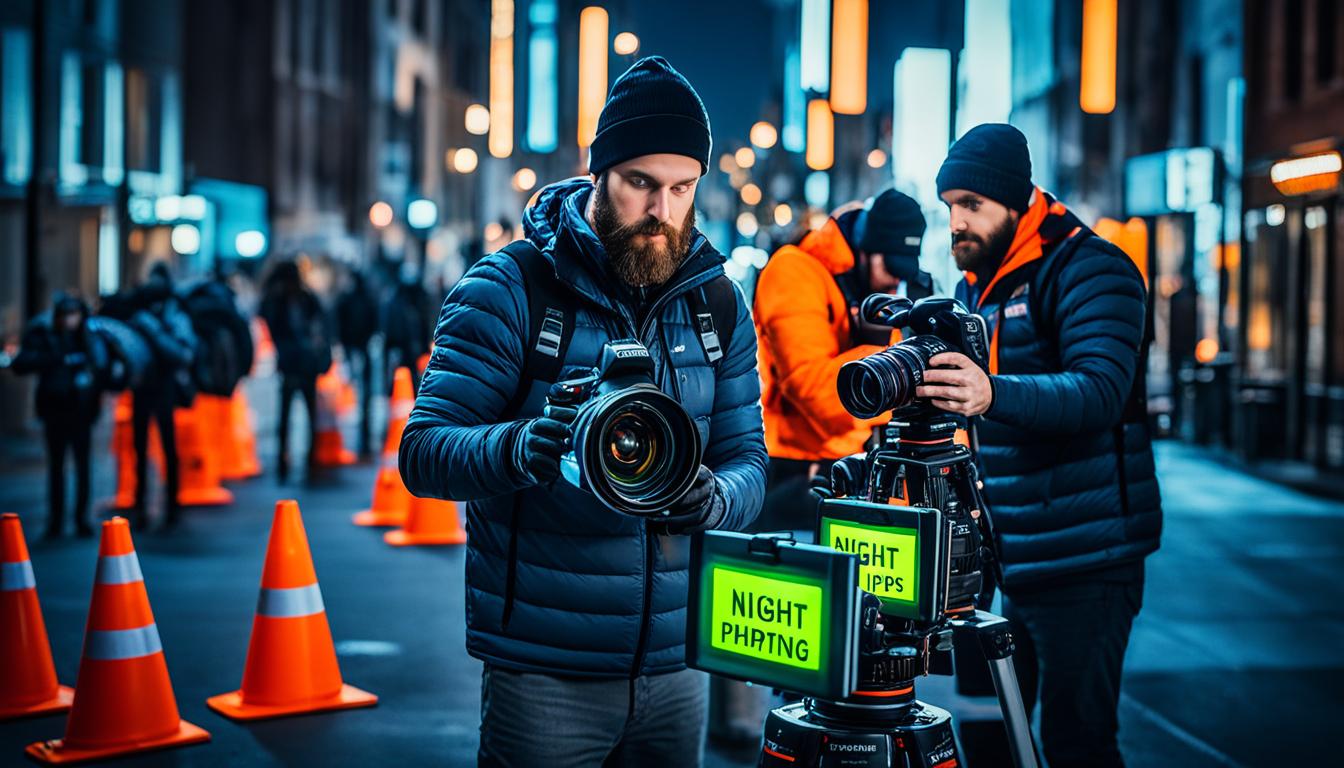Astrophotography is an extraordinary blend of photography and astronomy, enabling us to capture the mesmerizing beauty of the night sky. The art of astrophotography allows photographers like us to explore and document the celestial wonders, from distant galaxies to stunning star clusters. If you’re passionate about astrophotography, creating a portfolio of your work is an excellent way to showcase your skills and share your love for capturing the cosmos.
In this article, we will provide you with essential tips on building an impressive astrophotography portfolio that effectively conveys your talent and passion. Whether you’re a beginner or an experienced astrophotographer, these insights will help you create a digital portfolio that stands out among the stars.
Key Takeaways:
- Creating a portfolio of your astrophotography work allows you to showcase your skill and passion for capturing the wonders of the night sky.
- Astrophotography combines photography and astronomy, enabling you to explore and document the celestial beauty all around us.
- By showcasing your astrophotography portfolio, you can attract the attention of fellow photographers, enthusiasts, and potential clients.
- A well-curated portfolio should include a selection of your best astrophotography images, demonstrating your technical proficiency and artistic vision.
- An online platform like Portfoliobox can help you create a professional-looking digital portfolio to share your work with others.
Introduction to Astrophotography
Astrophotography is the art of capturing breathtaking images of astronomical objects and phenomena. With this unique form of photography, we can explore and document the unseen beauty of the cosmos. From distant galaxies to stunning star clusters, astrophotography offers us a glimpse into the wonders of the night sky.
There are different types of astrophotography, each with its own set of challenges and rewards. Let’s take a closer look:
- Wide-Field Astrophotography: This type of astrophotography involves capturing vast areas of the night sky, often using wide-angle lenses to include a large portion of the celestial landscape. It allows us to showcase the grandeur of the stars against dramatic landscapes or other interesting foreground elements.
- Solar System Astrophotography: As the name suggests, solar system astrophotography focuses on capturing the planets, moons, and other objects within our solar system. It requires precise timing, specialized filters, and high-magnification equipment to photograph the fascinating details of celestial neighbors like Jupiter, Saturn, and Mars.
- Deep-Sky Astrophotography: Deep-sky astrophotography takes us beyond our solar system to capture distant galaxies, nebulae, and star clusters. It often involves long-exposure photography and specialized equipment like telescopes and equatorial mounts to track the apparent motion of these celestial objects.
| Type of Astrophotography | Description |
|---|---|
| Wide-Field Astrophotography | Capturing vast areas of the night sky using wide-angle lenses. |
| Solar System Astrophotography | Photographing planets, moons, and other objects within our solar system. |
| Deep-Sky Astrophotography | Exploring distant galaxies, nebulae, and star clusters. |
For beginners venturing into astrophotography, it’s important to start with the basics. Familiarize yourself with the equipment needed, such as cameras, lenses, tripods, and accessories. Understanding the fundamentals of exposure, focusing techniques, and image processing will also greatly contribute to your astrophotography journey.
“Astrophotography is an awe-inspiring art that brings the wonders of the universe into our hands, allowing us to appreciate the vastness and beauty of the cosmos.” – Neil deGrasse Tyson
Essential Equipment for Astrophotography
To capture stunning astrophotography images, you’ll need the right equipment. Let’s take a look at the essential gear you’ll need for your astrophotography adventures.
Camera for Astrophotography
A high-quality camera is the backbone of any astrophotography setup. For optimal image quality and low noise, we recommend using a full-frame camera like the Nikon D850 or Canon EOS 5D Mark IV. These cameras have larger sensors that capture more light, resulting in sharper details and better low-light performance.
Lenses for Astrophotography
A wide-angle lens is crucial for capturing the vastness of the night sky. Opt for a fast lens with a wide aperture, such as the Samyang 14mm f/2.8 or the Rokinon 24mm f/1.4. These lenses allow more light to enter the camera, enabling shorter exposure times and minimizing star movement.
Tripod for Astrophotography
A sturdy tripod is essential for astrophotography, as it provides stability during long exposures. Look for a tripod with a weight capacity that can support your camera and lens setup. The Manfrotto MT055CXPRO4 is a popular choice among astrophotographers for its durability and stability.
Telescope and Motorized Mount
If you’re interested in capturing the intricate details of deep-sky objects, investing in a telescope and a motorized mount is worthwhile. Telescopes like the Celestron NexStar 8SE and the Orion SkyQuest XT10i allow you to photograph galaxies, nebulae, and other celestial objects with remarkable clarity. Motorized mounts, such as the Sky-Watcher EQ6-R Pro, automatically track the stars, compensating for Earth’s rotation and eliminating star trails.
Image Editing Software
After capturing your astrophotography images, you’ll want to enhance them through post-processing. Software like Adobe Photoshop and PixInsight offer powerful tools for adjusting exposure, reducing noise, and bringing out the subtle details in your images.
Remember, the right equipment is instrumental in creating breathtaking astrophotography images. Consider your budget, photography goals, and level of expertise when selecting your gear.

Recommended Essential Equipment for Astrophotography
| Equipment | Model | Price |
|---|---|---|
| Full-Frame Camera | Nikon D850 | $2,799 |
| Wide-Angle Lens | Samyang 14mm f/2.8 | $299 |
| Tripod | Manfrotto MT055CXPRO4 | $349 |
| Telescope | Celestron NexStar 8SE | $1,199 |
| Motorized Mount | Sky-Watcher EQ6-R Pro | $1,395 |
| Image Editing Software | Adobe Photoshop | $20.99/month |
Tips for Capturing Stunning Astrophotography
Want to capture breathtaking images of the night sky? Here are some essential tips to help you elevate your astrophotography game and create truly stunning shots.
Finding the Perfect Location
When it comes to astrophotography, location is everything. To capture clear and vivid images, it’s crucial to find a dark area away from light pollution. Look for national parks, rural areas, or remote locations with minimal artificial light. This will allow you to capture the true beauty of the stars and galaxies.
Utilizing the Rule of 500
The rule of 500 is a handy technique to prevent star trails in your astrophotography images. To avoid noticeable star movement during long exposures, divide 500 by the focal length of your lens. The resulting value is the maximum exposure time in seconds before star trails become noticeable. For example, if you’re using a 50mm lens, the maximum exposure time would be 10 seconds (500/50 = 10).
Mastering Image Stacking
Noise can be a persistent issue in astrophotography, especially when capturing faint details of deep-sky objects. Image stacking techniques can help reduce noise while enhancing the overall quality and details of your images. By taking multiple exposures of the same scene and aligning them in post-processing software, you can effectively minimize noise and reveal hidden details.
Here’s an example of an image taken without image stacking:
| Single Image | Image Stacking |
|---|---|
Patience and Perseverance
Astrophotography is not a sprint; it’s a marathon. Don’t get discouraged if your first attempts don’t turn out as expected. It takes time and practice to develop the necessary skills and techniques. Experiment with different camera settings, compositions, and subjects. Embrace the learning process and keep pushing yourself to capture that perfect shot of the night sky.
With these tips in mind, you’ll be well on your way to capturing stunning and awe-inspiring astrophotography images. Get out there, explore the cosmos, and let your photography skills shine!
Showcasing Your Astrophotography in a Portfolio
Now that you have captured and processed your breathtaking astrophotography images, it’s time to showcase them in a portfolio that highlights your celestial talents. An online portfolio is a fantastic way to share your work with a global audience and attract potential opportunities within the astrophotography community.
One reliable platform for creating an exceptional online portfolio is Portfoliobox. With its intuitive interface and customizable templates, you can effortlessly design a professional-looking portfolio that beautifully showcases your astrophotography portfolio. From minimalist designs to stunning image galleries, Portfoliobox offers a range of options to suit your unique style and vision.
When creating your online portfolio, it’s crucial to organize your astrophotography images into different categories or projects. This allows viewers to navigate through your work effortlessly and provides a cohesive visual experience. Consider grouping your images by subjects like galaxies, nebulae, or celestial events to showcase your versatility as an astrophotographer.
While an online portfolio is a fantastic way to reach a wider audience and establish your online presence, there’s something undeniably special about printing your astrophotography images. Tangible prints offer an immersive experience, allowing viewers to appreciate the intricate details and vibrant colors of your celestial captures.
Professional printing services like Bay Photo Lab or Nations Photo Lab can transform your digital images into high-quality prints, ensuring that the depth and beauty of your astrophotography are fully realized. Consider selecting different print sizes to add diversity and visual interest to your printed portfolio.
Benefits of Printing Astrophotography Images
Printing your astrophotography images offers a range of benefits:
- Tangible Display: Printed images provide a tactile experience that invites viewers to hold, examine, and appreciate your work in a physical form.
- Color Accuracy: Professional printing labs ensure accurate color reproduction, showcasing the exact hues and tones you captured in your astrophotography images.
- Artistic Expression: By printing your images, you have the opportunity to experiment with different paper types and finishes, adding texture and enhancing the overall visual impact of your portfolio.
- Personalization: Physical prints allow you to sign and number your limited edition astrophotography prints, making each piece unique and increasing its value.
The combination of an online portfolio and printed images allows you to reach a broad audience while also offering a tangible, personal connection through your physical portfolio. By leveraging the power of Portfoliobox and professional printing services, you can create a comprehensive platform that showcases your astrophotography skills and captivates viewers worldwide.

Conclusion
Creating a portfolio of your astrophotography work is a rewarding way to showcase your talent and passion for capturing the celestial wonders of the night sky. It not only allows you to share your captivating images with others but also serves as a testament to your dedication and skill in the field. As you continue on your astrophotography journey, there are several next steps you can take to enhance your skills and take your work to new heights.
One of the key next steps in astrophotography is to keep learning and exploring advanced concepts. There is always more to discover and understand about the vast universe we photograph. Dive deeper into topics such as advanced post-processing techniques, image stacking, and using specialized equipment to capture even more stunning astrophotography images.
Another important aspect of your astrophotography journey is to engage with the community. Join photography forums, participate in online astrophotography groups, and attend workshops and events where you can connect with fellow enthusiasts. The exchange of ideas, feedback, and experiences can be invaluable in refining your craft and staying updated with the latest trends and technologies.
Above all, enjoy the process and have fun! Astrophotography is a unique blend of science and art, allowing you to capture the beauty of the universe through your lens. Embrace the challenges, learn from your mistakes, and relish the moments when you capture that perfect shot. Your astrophotography journey is a lifelong adventure, filled with endless possibilities and discoveries in the captivating realm of the night sky.
FAQ
What is astrophotography?
Astrophotography is the art of photographing astronomical objects and phenomena.
What types of astrophotography are there?
There are different types of astrophotography, including wide-field, solar system, and deep-sky astrophotography.
What equipment do I need for astrophotography?
Essential equipment for astrophotography includes a full-frame camera, wide-angle lens, tripod, telescope (optional), motorized mount (optional), and image editing software.
How can I capture stunning astrophotography images?
To capture stunning astrophotography images, find a dark location away from light pollution, use the rule of 500 to avoid star trails, and use image stacking techniques to reduce noise and enhance details.
How can I showcase my astrophotography in a portfolio?
You can use an online portfolio platform like Portfoliobox to create a professional-looking portfolio. Additionally, printing your images is a great way to showcase your astrophotography skills in a physical form.
What are the next steps in my astrophotography journey?
As you continue your astrophotography journey, remember to keep learning and exploring advanced concepts to further enhance your skills. Enjoy the process and have fun capturing the beauty of the universe through your lens.
How Can I Use Time-Lapse Astrophotography to Enhance My Portfolio of Astrophotography Work?
Using timelapse astrophotography mastery can greatly enhance your portfolio of astrophotography work. By capturing multiple images over an extended period, you can showcase the movement and beauty of celestial objects such as stars, galaxies, and the Milky Way. Timelapse astrophotography adds a dynamic element to your portfolio, captivating viewers with mesmerizing transitions and showing the passage of time in the night sky.




